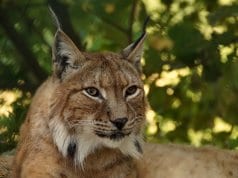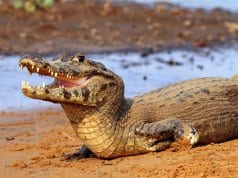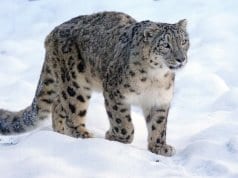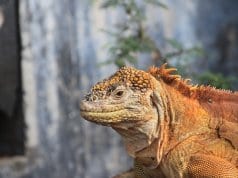Located about 125 miles northwest of Perth, Nambung National Park is one of the most beautiful places in all of Australia. Situated in the Pinnacles Desert, the park is likely best known for the limestone pillars that rise from the sands below. However, the park is also home to an array of wild animals, making it an ideal destination for wildlife lovers who are visiting the Perth area.
We’ll point out some of the park’s most notable wildlife species below, and we’ll also provide a few tips that may help you spot more species during your visit. If you employ the tips provided and enjoy a bit of luck, you’ll likely leave the park with a memory card full of photos and a smile on your face.
The Birds of Nambung National Park
More than 128 bird species live in the park during portions of the year.
Given its largely flat landscape, Nambung National Park is a fantastic destination for bird watchers. The park is home to a diverse array of species, so you may be able to check off several entries on your life list.

A few of the most commonly seen species include the white-backed swallow and red-capped plover. White-backed swallows are actually common across most of Australia, so it isn’t surprising to see them in Nambung National Park. Like most other swallows, they primarily feed on insects. Red-capped plovers, on the other hand, are only common near the coasts, where they feed on insects and crustaceans.
Ravens and silver gulls are also quite common in the park. They’re both medium to large species, who tend to be quite gregarious and form large flocks. Both ravens and silver gulls are opportunistic scavengers, who’ll eat just about anything they can find (including human food and refuse).
Reptiles of the Outback
Like most other Australian parks, Nambung National Park is home to several reptile species.
Australia is famous for being a haven for reptiles, and Nambung National Park is no exception. Dozens of snakes and lizards call the park home. Two of the most notable species include the sand goanna and the shingleback lizard (sometimes called a bobtail).

The shingleback lizard primarily feeds on insects and other invertebrates. If threatened by a predator, they’ll open their mouths and extend their bright blue tongues, which often confuses and startles predators, thereby allowing the shingleback lizard to escape. The sand goanna is a large species, which often reaches 4 feet in length or more. They’ll consume virtually any animal they can overpower, including the region’s venomous snakes.
Speaking of venomous snakes, one of the most common inhabitants of Nambung National Park is the western brown snake – colloquially known as the qwardar. These snakes typically keep their distance from humans and prefer to live quiet lives consuming rodents, snakes and lizards.
Marsupials of Nambung National Park
Eight different marsupial species consider Nambung National Park home.
Although a few placental mammals have been introduced by humans, the vast majority of mammals native to Australia are marsupials (with bats and a few rodent species being notable exceptions to the rule). So, it shouldn’t be surprising that several mammal species call Nambung National Park home.

Both western grey kangaroos and red kangaroos live within the park’s borders. Both species are rather large, but while the grey kangaroos rarely exceed 120 pounds in weight, mature male red kangaroos frequently exceed this size. The largest red kangaroos approach 200 pounds in weight.
But not all marsupials living in Nambung National Park are large. In fact, at least one native marsupial – the honey possum – is positively tiny. These arboreal possums weigh about ½ ounce – roughly half the weight of an adult mouse. These critters are typically nocturnal, but you may be able to spot them climbing during overcast days.
Wildlife-Viewing Tips
Employ the following tips to make the most of your Nambung National Park adventure.
Nambung National Park is easily one of the best national parks in the world for wildlife lovers to visit. But that doesn’t mean it is always easy to see some of the park’s native creatures. Occasionally, visitors to the park fail to see many animals at all.
But, if you employ the following tips and tricks, you can greatly increase your chances of seeing a variety of species.
- Bring binoculars with you. You should always bring binoculars along anytime you intend to do some birdwatching. However, it is especially important to do so when visiting Nambung National Park, thanks to the wide-open nature of the land.
- Watch where you put your hands and feet. Although the dangers presented by Australia wildlife species are largely exaggerated, there are several dangerous species in and around the park. Accordingly, it is important that you are careful to avoid stepping into places in which you can’t clearly see or sticking your hands in rock crevices.
- Concentrate on exploring during the early morning hours. It can get quite hot during the middle of the day in Nambung, and this often causes the local wildlife species to lay low and try to avoid the heat. However, if you get out early in the day – before temperatures peak – you can often spot a variety of creatures.

Share Your Experiences!
As you can see, Nambung National Park is one of the most remarkable places to visit in Australia. It not only provides visitors with the chance to see beautiful, naturally occurring rock formations, it is also home to a variety of wildlife species.
Have you ever had the chance to visit Nambung National Park? We’d love to hear about your experiences! Did you see a lot of wild animals during your trip? Did you visit during the annual flower bloom? Let us know all about your trip and the animals you observed in the comments below.






![Red Angus Closeup of a beautiful Red Angus cowPhoto by: U.S. Department of Agriculture [pubic domain]https://creativecommons.org/licenses/by/2.0/](https://animals.net/wp-content/uploads/2020/03/Red-Angus-4-100x75.jpg)

